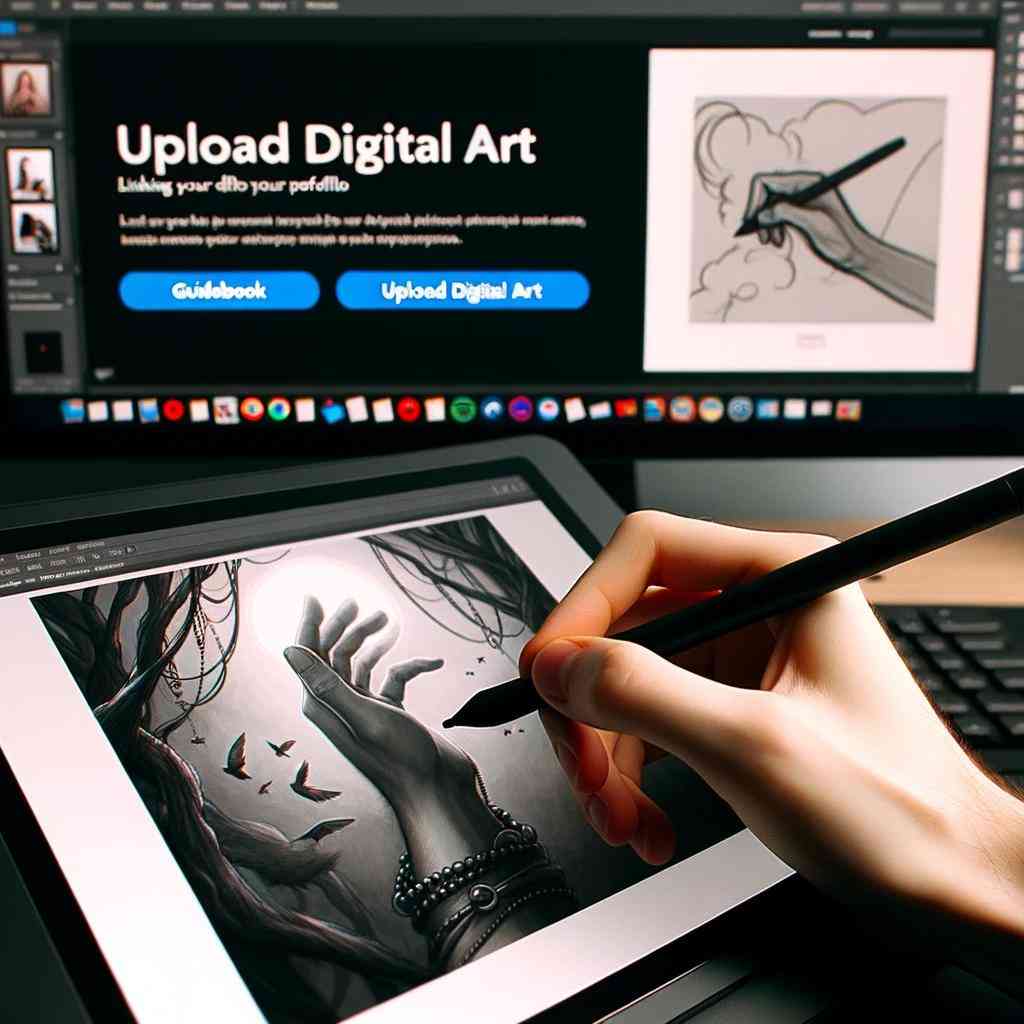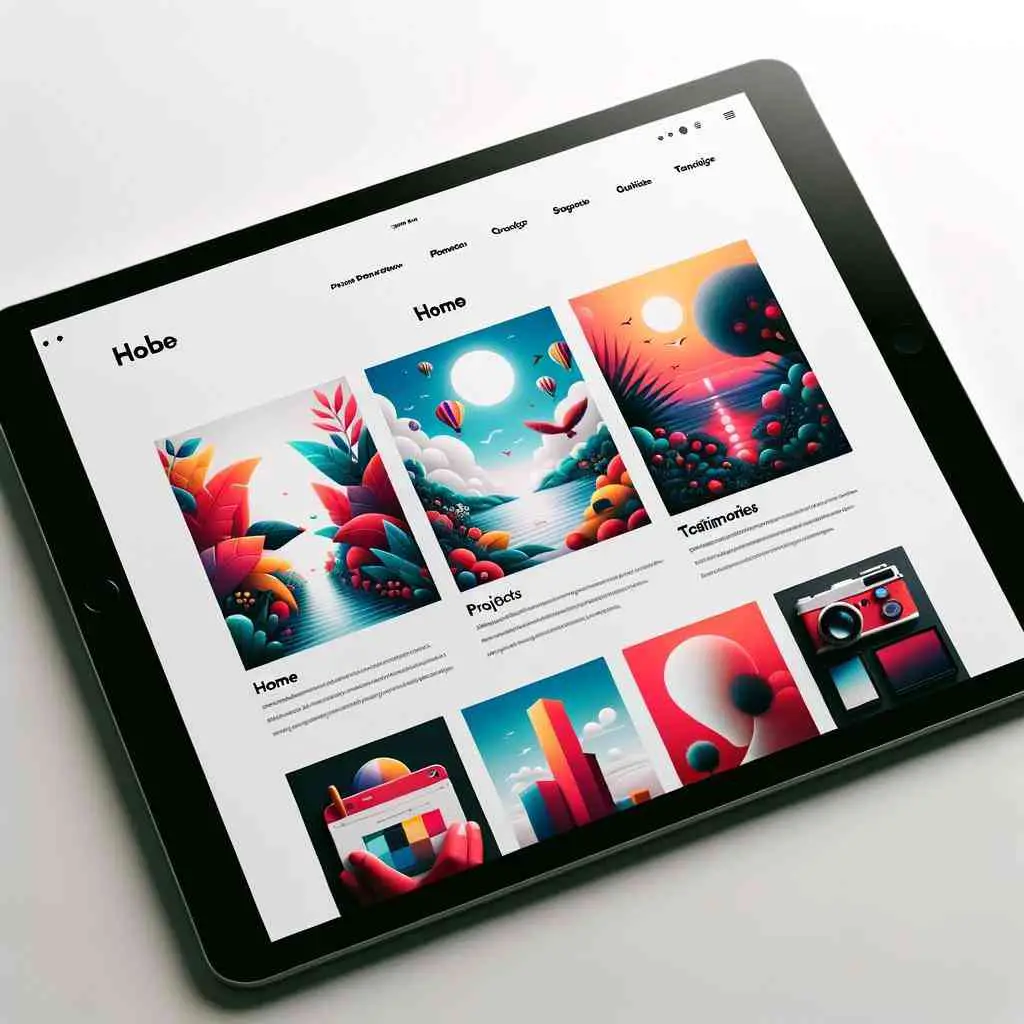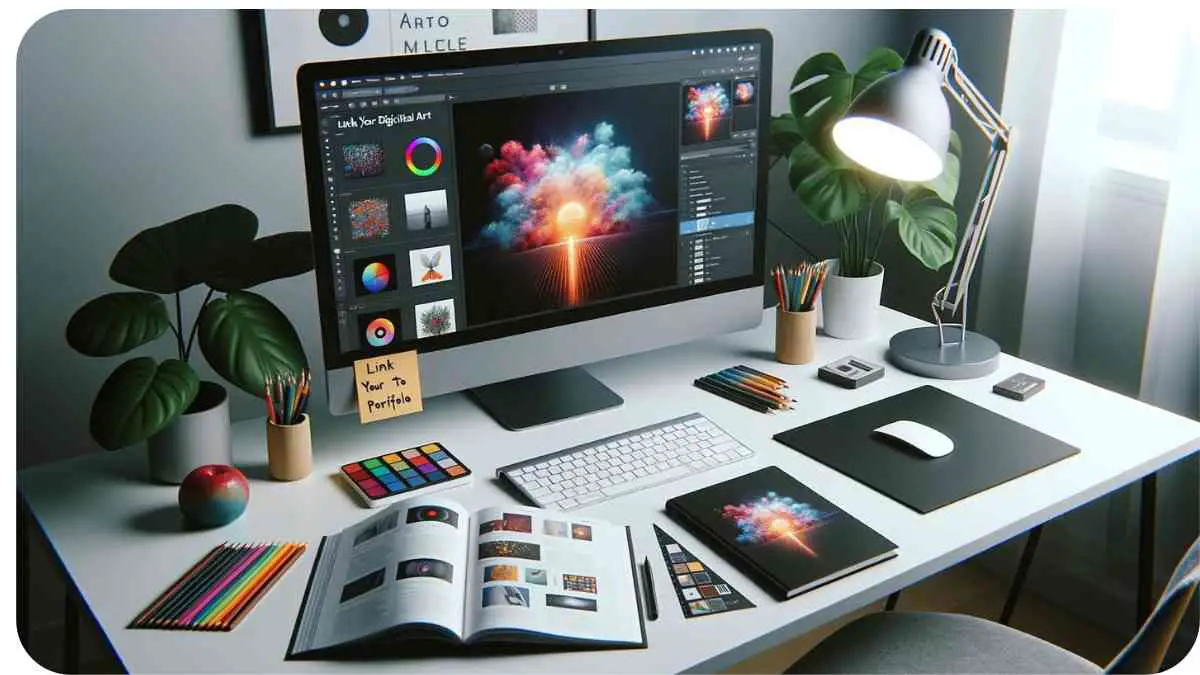Welcome to “Linking Your Digital Art to Your Portfolio: A Quick Guide.” In this comprehensive guide, we’ll explore the crucial steps to connect your digital art with your portfolio effectively. Whether you’re an aspiring digital artist or an experienced pro looking to enhance your online presence, this guide is tailored to help you succeed.
| Key Takeaways |
|---|
| 1. Quality Over Quantity: Focus on showcasing your best and most representative digital art pieces in your portfolio. |
| 2. Optimize for SEO: Utilize keywords, high-quality descriptions, backlinks, and user-friendly design to improve your portfolio’s visibility on search engines. |
| 3. Engage Your Audience: Respond to feedback, build an online community, and create a strong online presence through social media and collaborations. |
| 4. Monetize Your Art: Explore opportunities like selling prints, merchandise, commissions, and collaborations to turn your passion into income. |
| 5. Legal Protection: Understand copyright, licensing, and contracts to protect your digital art and ensure fair compensation for your work. |
| 6. Stay Updated: Continuously learn and stay informed about industry trends and techniques to evolve as a digital artist. |
2. Why Linking Your Digital Art Matters

Before we dive into the specifics, let’s understand why linking your digital art to your portfolio is essential. In today’s digital age, showcasing your artwork online can open doors to a world of opportunities. It allows you to reach a global audience, gain recognition, and even monetize your talent.
When building your digital art portfolio, remember that the right scrapbooking supplies can elevate your presentation. Just like selecting the perfect paintbrush, choosing the right materials is crucial to showcasing your work effectively.
3. Building a Strong Digital Art Portfolio
3.1 Selecting Your Best Work
When curating your portfolio, focus on showcasing your best and most representative pieces. Think of it as a curated art exhibition—quality over quantity.
3.2 Organizing Your Portfolio
A well-organized portfolio makes it easier for viewers to navigate. Use categories, tags, or themes to create a structured experience.
3.3 Showcasing Your Unique Style
Highlight what sets your art apart. Discuss your style, influences, and what makes your work special.
Table 1: Sample Portfolio Organization
| Category | Description |
| Digital Paintings | Realistic and fantasy genres |
| Character Design | Unique character concepts |
| Fan Art | Pop culture inspired art |
4. Connecting Your Digital Art to Your Portfolio

4.1 Leveraging Social Media
Social media platforms are powerful tools for artists. Share your work on platforms like Instagram, Twitter, and Pinterest to gain visibility.
4.2 Creating a Portfolio Website
Having a dedicated website gives you full control over your brand and presentation. Showcase your art in a way that reflects your style.
In the world of digital art, creating your own albums and journals is akin to curating your artist’s portfolio. Explore the art of DIY scrapbooking and craft your unique artistic narrative within your portfolio.”
4.3 Utilizing Online Art Platforms
Join art communities like DeviantArt, ArtStation, or Behance to reach a broader audience and connect with fellow artists.
Table 2: Popular Art Platforms
| Platform | Focus | Notable Features |
| DeviantArt | Diverse Art Styles | Active Art Community |
| ArtStation | Professional Art | Job Listings for Artists |
| Behance | Creative Portfolios | Adobe Integration |
When it comes to connecting your art with your portfolio, each platform has its unique strengths and opportunities. Let’s delve deeper into how you can effectively utilize social media, create your portfolio website, and leverage online art platforms to your advantage.
4.1 Leveraging Social Media
Social media platforms are a goldmine for artists seeking exposure. Here, I’ll share my experience with harnessing the power of social media to connect my digital art to my portfolio.
Instagram: Your Visual Showcase
Instagram, with its visually-centric approach, is a fantastic platform to display your art. With a well-curated feed, you can entice art enthusiasts and potential clients.
Digital artists often explore a wide range of creative outlets. These incredible paper crafts offer a fresh perspective and can inspire innovative ways to display your digital artistry within your portfolio.
Table 3: Instagram Posting Schedule
| Day | Time | Content |
| Monday | 2 PM | New Artwork Showcase |
| Wednesday | 7 PM | Behind-the-Scenes |
| Friday | 12 PM (noon) | Fan Art Feature Friday |
Twitter: Engaging with the Art Community
Twitter’s conversational nature allows you to engage with fellow artists and art lovers. Use hashtags to reach a wider audience.
Table 4: Twitter Hashtags for Artists
| Hashtag | Purpose |
| #ArtShare | Share your artwork |
| #ArtistSupport | Promote fellow artists |
| #WIPWednesday | Work-in-progress posts |
4.2 Creating a Portfolio Website

Having your website is like having your art gallery. It’s a place where you have full control over your brand and presentation.
Table 5: Essential Portfolio Website Elements
| Element | Purpose |
| Homepage | Introduction and featured art |
| Portfolio Gallery | Showcase your best work |
| About Page | Share your story and artistic journey |
| Contact Page | Make it easy for visitors to reach out to you |
4.3 Utilizing Online Art Platforms
Joining online art communities can expose your work to a broader audience and provide valuable networking opportunities.
Unleash your creativity by incorporating elements from amazing paper mache projects into your digital art portfolio. The tactile and imaginative nature of paper mache can infuse new life into your presentation
Table 6: Benefits of Online Art Platforms
| Benefit | Explanation |
| Exposure | Reach a global audience |
| Feedback and Critique | Receive constructive criticism |
| Collaboration | Connect with other artists for projects |
| Job Opportunities | Find freelance or full-time work in the industry |
Now that we’ve explored these key strategies, let’s move on to optimizing your digital art portfolio for search engines in the next section.
5. SEO Strategies for Your Digital Art Portfolio
Optimizing your portfolio for search engines is crucial to ensure that your art gets discovered online. Let’s delve into some effective SEO strategies while also incorporating tables where they make sense.
5.1 Keywords and Metadata
Table 7: Sample Artwork Metadata
| Field | Description |
| Title | Descriptive and engaging |
| Description | Detailed and relevant |
| Tags/Keywords | Relevant to the artwork |
| Category | Art style, genre, or medium |
When adding your digital art to your portfolio, pay close attention to the metadata you provide. Choose descriptive titles, write detailed descriptions, and use tags and keywords that accurately represent your work. This helps search engines understand and categorize your art effectively.
5.2 High-Quality Descriptions
Table 8: Example of a High-Quality Art Description
| Artwork Title | “Enchanted Forest” |
| Description | Explore the mystical depths of an enchanted forest in this mesmerizing digital painting. Vibrant hues and intricate details bring this magical world to life. Let your imagination wander as you lose yourself in the beauty of nature’s secrets. |
Crafting compelling and unique descriptions for your artwork not only enhances your SEO but also engages your audience. Tell a story or evoke emotions through your descriptions to captivate viewers.
5.3 Backlinks and References
Table 9: Backlinking Strategies
| Strategy | Description |
| Guest Blogging | Write guest posts on art-related websites |
| Collaboration | Partner with other artists for joint projects |
| Art Community Forums | Participate in discussions and share your work |
Building backlinks from reputable sources can improve your portfolio’s authority and search engine rankings. Collaborate with other artists, write guest posts, and engage in art community forums to create valuable links.
5.4 User Experience and Accessibility
Table 10: Website Usability Tips
| Tip | Description |
| Mobile Responsiveness | Ensure your portfolio is mobile-friendly |
| Fast Loading Speed | Optimize images and page speed for quick access |
| Alt Text for Images | Describe images for visually impaired users |
| Clear Navigation | Make it easy for visitors to explore your art |
Creating an excellent user experience on your portfolio website is vital. A fast, accessible, and user-friendly website not only pleases visitors but also positively impacts your SEO.
By incorporating these SEO strategies into your digital art portfolio, you’ll increase your chances of ranking higher in search engine results, attracting more art enthusiasts, and gaining recognition in the digital art community.
6. Measuring Success

Understanding the impact of your efforts is essential. Let’s explore ways to measure the success of your linked digital art portfolio.
6.1 Google Analytics
Table 11: Key Google Analytics Metrics
| Metric | Description |
| Page Views | How many times your portfolio is viewed |
| Bounce Rate | Percentage of visitors who leave quickly |
| Conversion Rate | Rate of visitors who take desired actions |
| Traffic Sources | Where your visitors are coming from |
Google Analytics provides valuable insights into your website’s performance. Monitor these metrics to gauge your portfolio’s success and make necessary improvements.
6.2 Social Media Insights
Table 12: Social Media Analytics
| Platform | Metrics to Track |
| Likes, Comments, Follower Growth | |
| Retweets, Replies, Impressions | |
| Pins, Clicks, Engagement Rate |
Each social media platform offers insights into your content’s performance. Analyze these metrics to refine your social media strategy.
Now that we’ve discussed measuring success, let’s explore how you can engage with your audience effectively in the next section.
7. Engaging with Your Audience
Engaging with your audience is a vital aspect of building a successful digital art portfolio. Let’s explore some strategies and, where applicable, include relevant tables.
7.1 Responding to Feedback
Table 13: Tips for Responding to Feedback
| Tip | Description |
| Timely Responses | Acknowledge comments and messages promptly |
| Constructive Feedback | Welcome critique and use it to improve |
| Show Appreciation | Thank your audience for their support |
| Address Concerns | Resolve any issues or concerns professionally |
Engaging with your audience involves more than just responding to positive feedback. Be open to constructive criticism, show gratitude, and address any concerns promptly and professionally.
7.2 Building an Online Community
Table 14: Building an Online Art Community
| Strategy | Description |
| Art Challenges | Host or participate in art challenges |
| Live Streaming | Interact with your audience in real-time |
| Collaborative Projects | Collaborate with other artists and creators |
| Discussion Forums | Create or join forums related to your niche |
Fostering a sense of community around your art can lead to a dedicated and supportive fan base. Engage with your audience through art challenges, live streaming, collaborations, and online forums.
As an experienced digital artist, I’ve found that connecting with your audience not only enhances your portfolio’s appeal but also creates a more fulfilling and enjoyable artistic journey. Let’s now explore how you can monetize your digital art portfolio.
8. Monetizing Your Digital Art Portfolio
Turning your passion into a source of income is a dream for many artists. Let’s discuss various ways you can monetize your digital art portfolio, and where relevant, include tables for clarity.
8.1 Selling Prints and Merchandise
Table 15: Popular Print-on-Demand Platforms
| Platform | Key Features |
| Society6 | Art prints, home decor, apparel |
| Redbubble | Diverse product range |
| Etsy | Handmade and unique items |
| Printful | White-label printing services |
Selling prints and merchandise of your digital art can be a lucrative venture. Choose a platform that aligns with your artistic style and goals.
8.2 Commissions and Collaborations
Table 16: Commission Pricing Guidelines
| Artwork Type | Average Price Range |
| Portraits | $100 – $500 |
| Illustrations | $200 – $1,000 |
| Concept Art | $300 – $2,000 |
| Character Design | $500 – $2,500 |
Offering commissions allows you to create custom art for clients. Set competitive prices and showcase your previous work to attract potential clients.
Monetizing your digital art portfolio can provide you with a steady income while doing what you love. Explore various options, experiment, and find what works best for you.
9. Legal Considerations
As your digital art career flourishes, it’s crucial to be aware of legal aspects to protect your work and yourself. Let’s delve into some key legal considerations.
9.1 Copyright and Licensing
Table 17: Copyright and Licensing Terms
| Term | Description |
| Copyright | Your exclusive rights as the creator |
| Creative Commons | Allows others to use your work |
| Public Domain | Free for anyone to use |
| Royalties | Earnings from licensed use of your art |
Understanding copyright, licensing, and how to protect your intellectual property is essential to safeguard your digital art.
9.2 Contracts and Agreements
Table 18: Elements of a Commission Agreement
| Element | Purpose |
| Payment Terms | Define payment schedules and methods |
| Art Specifications | Detail the scope and expectations |
| Rights and Usage | Specify how the art can be used |
| Deadlines | Set project completion deadlines |
When working with clients or collaborators, having clear contracts and agreements in place helps prevent misunderstandings and ensures fair compensation.
10. Overcoming Challenges
The journey of a digital artist isn’t without its challenges. Let’s explore some common hurdles and strategies to overcome them.
10.1 Dealing with Copycats
Table 19: Protecting Your Art from Copycats
| Strategy | Description |
| Watermarking | Overlay your art with a subtle watermark |
| Copyright Registration | Officially register your copyright |
| Legal Action | Take legal steps if necessary |
Protecting your art from copycats requires vigilance and, in some cases, legal action. Be proactive in safeguarding your work.
10.2 Handling Negative Feedback
Table 20: Coping with Negative Feedback
| Approach | Description |
| Stay Constructive | Use criticism as a tool for improvement |
| Ignore Trolls | Avoid engaging with unproductive comments |
| Seek Support | Talk to fellow artists for advice and comfort |
Negative feedback is a part of any artist’s journey. Learn to handle it constructively and focus on your growth as an artist.
10.3 Managing Time and Burnout
Table 21: Time Management Tips
| Tip | Description |
| Set Boundaries | Balance work and personal life |
| Prioritize Tasks | Focus on high-impact tasks first |
| Take Breaks | Prevent burnout with regular breaks |
| Learn to Say No | Avoid overcommitting to projects |
Managing your time and avoiding burnout is crucial for long-term success as a digital artist. Establish healthy work habits and maintain a sustainable pace.
11. Staying Updated in the Digital Art World
The digital art world is constantly evolving, and staying current is essential to thrive in this dynamic field. Let’s explore strategies to keep yourself informed and inspired.
11.1 Online Courses and Workshops
Table 22: Online Learning Platforms
| Platform | Key Features |
| Skillshare | Diverse art courses and tutorials |
| Udemy | Art courses for various skill levels |
| Coursera | Courses from top universities and colleges |
Online courses and workshops offer a flexible way to learn new techniques, software, and artistic styles. They can also provide valuable networking opportunities.
11.2 Art Communities and Forums
Table 23: Active Art Communities
| Community | Description |
| ConceptArt.org | Emphasizes concept art and visual development |
| CGSociety | Focuses on digital art and animation |
| WetCanvas | A diverse community for all art forms |
Participating in art communities and forums allows you to connect with fellow artists, share experiences, and gain insights into industry trends.
11.3 Industry Events and Conventions
Table 24: Major Art Conventions
| Event | Focus |
| Adobe MAX | Adobe’s annual creativity conference |
| Comic-Con | Celebrating comics, film, and pop culture |
| SIGGRAPH | Focus on computer graphics and interactive techniques |
Attending industry events and conventions can provide you with firsthand exposure to new tools, techniques, and emerging trends in digital art.
By actively staying updated and engaged in the digital art world, you’ll continue to grow as an artist and keep your portfolio fresh and relevant.
12. Conclusion
In conclusion, linking your digital art to your portfolio is a crucial step in establishing your online presence as an artist. We’ve covered a wide range of topics in this quick guide, from building a strong portfolio to monetizing your art and overcoming challenges. Remember that success in the digital art world takes time, dedication, and continuous learning.
As you embark on your journey, leverage the power of social media, create a captivating portfolio website, and optimize your content for search engines. Engage with your audience, protect your work legally, and stay updated with the ever-evolving digital art landscape.
The world is waiting to discover your unique artistic voice, and with the right strategies and persistence, you can achieve your goals. So, go ahead, link your digital art to your portfolio, and let your creativity shine on the digital canvas of the internet.
If you have any questions or need further guidance on any of the topics discussed in this guide, feel free to reach out. Best of luck on your digital art adventure!
Further Reading
Here are some additional resources to help you further enhance your digital art portfolio:
- Adobe’s Guide on How to Make a Digital Art Portfolio
- Explore Adobe’s comprehensive guide on creating a digital art portfolio, with valuable insights and tips for artists.
- Artrepreneur: Create a Digital Art Portfolio
- Artrepreneur offers advice on building a standout digital art portfolio, covering essential aspects of presentation and promotion.
- LinkedIn: How Do You Create a Portfolio for Digital Paintings?
- Discover professional advice on crafting a portfolio for digital paintings, shared by experienced artists on LinkedIn.
FAQs
How do I choose the best pieces for my digital art portfolio?
In selecting artwork for your portfolio, focus on pieces that represent your skills, style, and versatility. Choose those that demonstrate your proficiency and captivate your audience.
What should I include in the description of my digital art portfolio pieces?
Your descriptions should provide context, insights, and inspiration. Explain your artistic choices, techniques used, and the story behind each piece to engage viewers.
Is it necessary to create a dedicated website for my digital art portfolio?
While not mandatory, a dedicated portfolio website offers full control over your presentation and branding. It can enhance your professionalism and make your work more accessible.
How can I protect my digital art from copyright infringement?
To protect your art, consider copyright registration and watermarking. Additionally, be cautious about sharing high-resolution files online to minimize the risk of unauthorized use.
What strategies can I use to promote my digital art portfolio on social media?
Promote your portfolio on social media by maintaining a consistent posting schedule, using relevant hashtags, engaging with your audience, and collaborating with other artists for cross-promotion.

Hellen James is the creator of Unified Crafts and has been crafting since she was a kid accompanied by her mom to the craft store, where she was free to choose whatever ignited her imagination.

